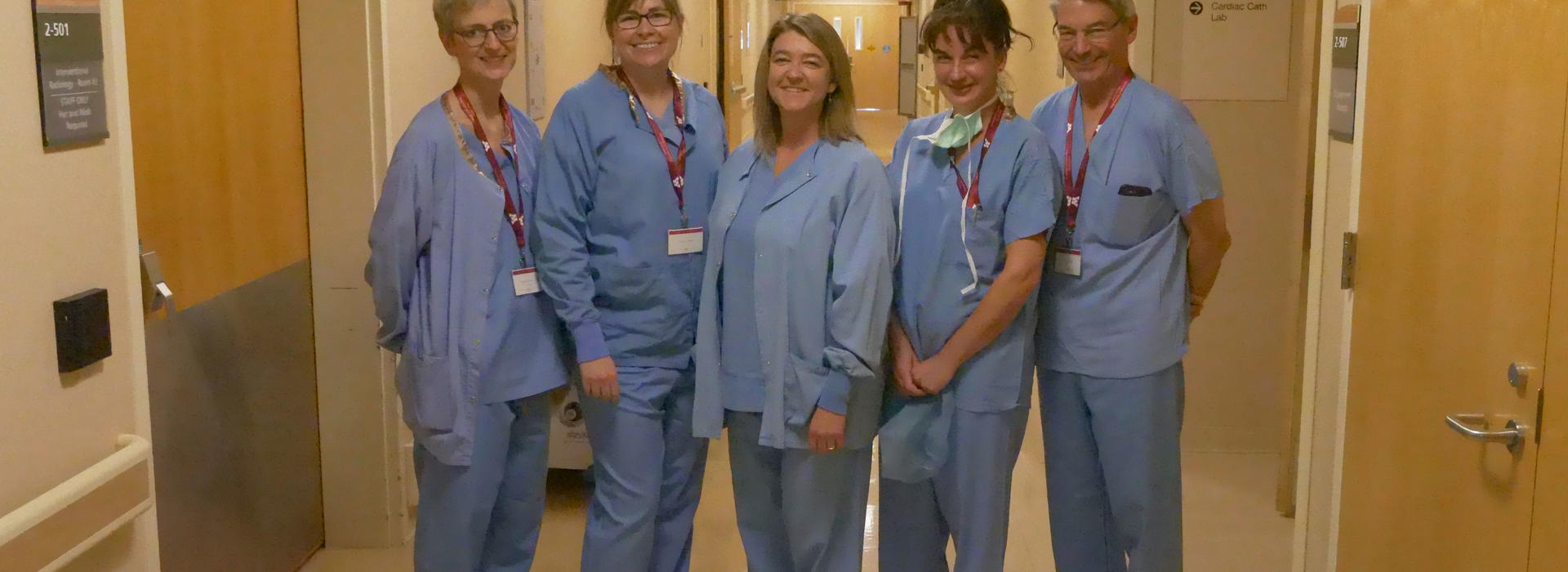
Medical Technology Companies Partner With U of M Medical School
Teri Whitman, PhD, works as a research engineer on medical devices for an international corporate powerhouse. But, if you met Dr. Whitman in college, you would know her original pursuit to be an engineer started with a desire to build a better hot dog.
“I had a strong interest in meat science and skeletal tissue and was pursuing food process engineering. Through my research, I met biomedical engineers who I learned were wanting to build an early warning device to use during surgery for infants that were reacting to halothane anesthesia. I thought, ‘Meat is good, but saving babies is better,’” she laughed. “And, that’s how I started down the road to biomedical engineering.”
From hot dogs to, now, defibrillators, Dr. Whitman and her team—made up of scientists, a pre-clinical surgeon and a design engineer—recently embedded themselves alongside University of Minnesota Medical School residents and faculty for a week-long “Clinical Immersion.” The program, led by the Medical School’s Institute for Engineering in Medicine (IEM), helps Dr. Whitman, as a creator of medical technology, see her devices in “the wild.”
“We aren’t the frontline users of our devices,” Dr. Whitman said. “So, it’s nice to venture out and see procedures that we may not know as much about. What doctors are looking for, the decision-making to use a device—it’s just nice to hear their clinical thought process.”
Although all medical devices, including those built by Dr. Whitman and her team, go through highly rigorous and regulated feasibility studies, opportunities like this help teams like hers envision the next big idea in advancing clinical delivery systems and patient care.
“You really get to see the needs. It’s the next best thing to get to talk to a physician and say, ‘I notice you had some trouble doing X, Y, and Z. What could help you with that?’” said Linnea Lentz, DVM, PhD, who is her team’s pre-clinical surgeon that tests medical device prototypes.
Dr. Lentz, Dr. Whitman and the team noticed, for example, how much space technology packaging takes up in an operating room that’s already crowded with dozens of staff. Leaving with these clinical-use experiences is the main goal of the program—the concept for which began as a vision of IEM Associate Director for Professional Education and Outreach Paul Iaizzo, PhD, who is also the principal investigator of the Visible Heart Laboratories in the Department of Surgery.
Dr. Iaizzo developed the model and laid the foundation for the Clinical Immersion Program by determining its activity and financial structure—all elements that have remained consistent since it was launched in 2015 with the Department of Surgery, and which have been adopted by successive clinical areas as the program has grown.
“The University of Minnesota has an outreach mission, and this program aims to foster such. The vision for the Clinical Immersion Program was to allow industry people to see the amazing clinical work being performed within M Health Fairview and to build new collaborations, friendships and perhaps inspire new opportunities for translational research and clinical trials,” Dr. Iaizzo said.
As the Clinical Immersion Program grew, Ken Rosen took over as the primary coordinator, who is also the IEM assistant director.
“They are going on patient rounds and getting a good feel for the workflow and patient flow that goes on. They see the environment in which their technologies are used, and it helps them to see where they fit in,” Rosen said.
Clinical immersions happen year-round. Industry professionals from companies—some from as far as Connecticut, Utah and Costa Rica—pick the type of immersion, including partial or week-long immersions. The programs offered include focus areas in general surgery, cardiology, which covers interventional cardiology, electrophysiology and cardiac surgery, as well as immersions in neurosurgery, interventional radiology and specialized settings like the ICU or wound care.
“It is a very supportive and friendly atmosphere,” Rosen said. “The providers at our University realize that these companies are developing technologies and products that will benefit their patients and their efforts to care for their patients, and they appreciate that the funds generated by the program are helping to support the clinical education of the host departments.”
Those funds, which total $5,000 per person for a week-long immersion, are shared between IEM and the hosting department. Nearly 80% goes directly to the department to fund clinical education for its residents. Since 2015, IEM’s clinical immersions have raised more than $1.3 million by hosting over 330 medical device professionals. Rosen said the partnership is a mutually beneficial one that the Medical School is specially positioned to lead.
“We are very uniquely suited to do this type of program because the providers here are very open to working with industry. A lot of hospitals and institutions aren’t,” he said. “Here, we’ve had a heritage of it. But, the other big thing that really makes it happen is that we are in the middle of what is known as, 'Medical Alley,' where a lot of medical device companies are based or have major operations, and we’re building off of that. Companies are starting to find us now.”
To learn more about the program or to get involved, please visit IEM’s website.